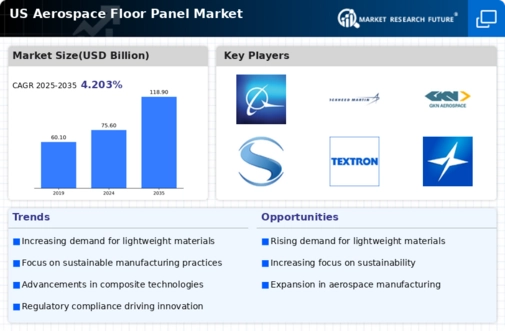Rising Demand for Aircraft
The aerospace floor-panel market is witnessing a notable increase in demand for new aircraft, driven by a resurgence in air travel and the expansion of commercial aviation. According to recent data, the US commercial aircraft fleet is expected to grow by over 3% annually, leading to a corresponding rise in the need for high-quality floor panels. This demand is further fueled by airlines seeking to modernize their fleets with more fuel-efficient and technologically advanced aircraft. Consequently, the aerospace floor-panel market is likely to experience robust growth as manufacturers ramp up production to meet the needs of both commercial and military sectors. The anticipated increase in aircraft deliveries is expected to create a favorable environment for the aerospace floor-panel market, potentially leading to a market valuation exceeding $1 billion by 2030.
Government Investments in Aerospace
The aerospace floor-panel market is benefiting from increased government investments in the aerospace sector. The US government has been actively funding research and development initiatives aimed at advancing aerospace technologies. This financial support is likely to stimulate innovation within the aerospace floor-panel market, encouraging manufacturers to explore new materials and production techniques. Additionally, government contracts for military aircraft are expected to drive demand for specialized floor panels that meet stringent performance criteria. As a result, the aerospace floor-panel market may experience a boost in growth opportunities, with potential increases in market size as government spending continues to support the industry.
Increased Focus on Passenger Comfort
In the aerospace floor-panel market, there is a growing emphasis on enhancing passenger comfort within aircraft interiors. Airlines are increasingly investing in cabin upgrades to improve the overall travel experience, which includes the installation of advanced flooring solutions. These solutions not only contribute to aesthetics but also play a vital role in noise reduction and thermal insulation. As airlines compete to attract customers, the demand for innovative floor-panel designs that enhance comfort is likely to rise. This trend is expected to drive growth in the aerospace floor-panel market, as manufacturers develop products that meet these evolving consumer preferences. The market could see a shift towards more luxurious and functional floor-panel options, potentially increasing the average selling price of these components.
Emerging Trends in Eco-Friendly Solutions
The aerospace floor-panel market is increasingly influenced by emerging trends focused on eco-friendly solutions. Manufacturers are exploring sustainable materials and production methods to reduce the environmental impact of aircraft manufacturing. This shift is driven by both regulatory pressures and consumer preferences for greener options. The aerospace floor-panel market is likely to see a rise in the adoption of recyclable and bio-based materials, which could enhance the sustainability profile of aircraft interiors. As airlines and manufacturers prioritize environmental responsibility, the demand for eco-friendly floor panels is expected to grow, potentially reshaping product offerings and market dynamics in the coming years.
Technological Advancements in Manufacturing
The aerospace floor-panel market is experiencing a surge in technological advancements that enhance manufacturing processes. Innovations such as additive manufacturing and automated assembly lines are streamlining production, reducing lead times, and improving precision. These advancements are crucial as they allow manufacturers to produce complex designs that were previously unattainable. The integration of advanced materials, such as composites, is also on the rise, contributing to weight reduction and improved performance. As a result, the market is projected to grow at a CAGR of approximately 5.2% over the next five years, driven by these technological improvements. The aerospace floor-panel market is thus positioned to benefit significantly from these developments, as they align with the increasing demand for efficiency and performance in aircraft design.

















Leave a Comment